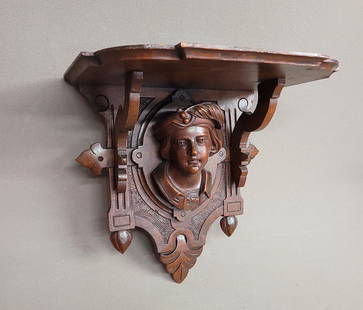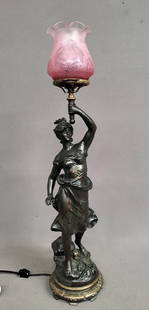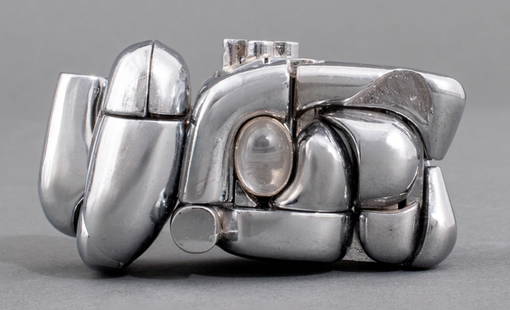
Enrico Caruso, Italian, 1873-1921, bronze sculptur
Similar Sale History
View More Items in Sculptures & CarvingsRelated Sculptures & Carvings
More Items in Sculptures & Carvings
View MoreRecommended Art
View More





Item Details
Description
Enrico Caruso, Italian, 1873-1921, bronze sculpture, "Laughing Buddha", , a self portrait understood to have been done as a gift to Arturo Toscanini, 6" high, 3 5/8" w, 3 5/8" deep, Good condition, with some light rubbing. Original rich brown patina. Signed "Roman Bronze Works" on the edge of the base. Also signed and dated "Enrico Caruso/1909". Enrico Caruso was born in a seven-story apartment complex in a working-class neighborhood in Naples, Italy. He was the 18th child out of 21, and the first to live past infancy, due to a cholera epidemic. His own survival through the epidemic was attributed to the breast milk of a "strong woman of high birth" who nursed him in place of his weak and sickly mother. He was born to a family of singers. His father, Marcellino Caruso, a mechanic in a local factory - and a heavy drinker, had a deep bass voice. His mother, Anna Baldini, a kind and gentlewoman whose health declined steadily with each of her previous pregnancies, was once known for her beautiful "bird-like" soprano voice. It was to be his mother's encouragement to perform throughout his early years that would mold him into the "King of Tenors" as he is known today. At the age of 10, his extraordinary voice had already drawn the attention of pianist Ernesto Schirardi and Maestro Raffaele di Lutio, who offered to tutor the young child in proper voice production and train his musical skills. However, his interest in drawing temporarily superseded his interest in private study. These skills later proved to be useful in his characterizations and score copying - a method he used for memorization. Eventually, Enrico stopped going to school entirely, deceiving his parents while meeting his friends at the railroad yards. When his father was informed of his son's whereabouts, he was enraged. He demanded that Enrico give up his education to work full-time at the factory, and only after a full day's work would he be permitted to continue his vocal studies. Enrico submitted to his father's demands, and yet continued to sing in churches and around the community. At the age of fifteen, Enrico stopped singing for a short period following the death of his ill mother. His voice was beginning to change, and was positive he would never sing again without her encouragement. Five months later, his father remarried to Maria Castaldi, a kind and intelligent woman with whom Enrico quickly bonded. Through her love and support, he later began to perform again, making use of his new baritone-tenor instrument. In 1890 he began performing the ever-popular Neapolitan songs after work in the city's waterfront cafés - a form of entertainment known as "café chantant." He soon gained the attention of many people, and was directed to study with on of the city's most distinguished teachers, Guglielmo Vergine, who reluctantly took him on without pay at the signing of a contract enabling Vergine to receive 25 percent of his total earnings for "five years of singing." The naive Caruso signed the contract, unaware that this stipulation referred to 1825 days of performances, and not merely a period of five calendar years. This contract was later annulled by an Italian court, but not without great expense to Caruso. Although these later disagreements with Vergine proved to be the end of their working relationship, he always credited a share of his success to him. "It was Vergine who emphasized the necessity of singing as nature intended," discouraging him to add too much weight to his voice prematurely. At the age of 21, Caruso was ready for his operatic debut, however, this was intercepted by Italian law which required his three years of military service at the Thirteenth Artillery at Rieti. He reluctantly went, but continued to sing by vocalizing in his spare time and entertaining his fellow soldiers. He was soon called to meet with his commanding officer, Major Nagliati, who claimed to find his sounds disturbing. As they proceeded to talk, the Major - a knowledgeable music lover - introduced Caruso to the Baron Costa, a nobleman of Rieti. The Baron, after hearing Caruso's voice, declared him to be extraordinarily gifted. Being an accomplished pianist, the Baron took him into his home, and taught Caruso his first rôle, Turridu in "Cavellaria Rusticana" in only five days. The Count was extremely impressed by the soldier's talents, and suggested to the Major that Caruso was wasting his time in the military. Caruso was soon dismissed after only two months of service, calling in his brother to replace him. Caruso then returned to Naples and soon made his debut with a relatively unknown opera "L'Amico Francesco." However, a year later he debuted at Caserta with the rôle of Turridu. Soon after, he premiered "Fedora" in Milan at the Opera Lirico. This would be the performance that launched his career. Caruso exclaimed "After that night, the contracts descended on me like a heavy rainstorm." Caruso made his Metropolitan Opera debut on the opening night of the 1903-04 season. Out of the 57 rôles and 832 performances, 37 roles and 607 performances were there at the Metropolitan Opera. In August of 1920, Caruso began to experience the early signs of what was to become his long battle with sickness. He complained in a letter to his secretary, Bruno Zirato, of "dolore in genere" or "pain all over." These pains were kept a secret to the public until a performance on December 8, when Caruso stumbled off the stage during his famed rôle of Canio in "I Pagliacci," after his voice dramatically broke on the high A at the end of "Vesti la Giubba." As he reached the edge of the curtain, he unknowingly fell unconscious into the arms of Zirato, and was carried to his dressing room. Three days later in Brooklyn, he began bleeding from the mouth during the love duet in "L'Elisir d'Amore." He sang only four more performances, including his final one. "La Juive" on Christmas Eve, 1920. Caruso was set to perform the Metropolitan Opera's debut of "Andrea Chènier," but due to his illness, was replaced by the newly popular Beniamino Gigli. On the Christmas day following "La Juive," Caruso was sharing a peaceful evening with his wife and one year old daughter Gloria, when he began violently screaming. The pain was beginning to envelop his body. After six operations by seven doctors, and an unapproved blood transfusion, his health began to decline quickly. Possibly foreseeing the nearness of death, he paid his last respects to the Metropolitan's employees, and returned to Naples to reunite with family and friends. By July 30, 1921, a delirium has set in on the sickly Caruso, and his temperature rose dramatically. The next day he was to be rushed via train to Rome, where a top surgeon awaited his arrival for an emergency surgery. Before the train arrived, he took a turn for the worse. The next 48 hours were those of excruciating pain, in which he would continually moan, "Calore . . . dolore . . . calore . . . dolore!" (heat, pain). Caruso's suffering finally ended on the morning of Aug 2, 1921, shortly after nine o'clock. Gulio Gatti-Cassazza, administrator of the La Scala Opera, wrote this of Caruso, immediately after learning of his death: "We may have now and later tenors possessing some of his qualities, i.e., who may have a beautiful voice, who may be good singers or artists, etc., but I think it will almost be impossible to have the fortune to find again another personality who possesses in himself all the artistic and moral gifts that distinguished our poor and illustrious friend," By Michael J. Cochran
Buyer's Premium
- 23%
Enrico Caruso, Italian, 1873-1921, bronze sculptur
Estimate $400 - $800
8 bidders are watching this item.
Shipping & Pickup Options
Item located in Chadds Ford, PA, usSee Policy for Shipping
Payment

Related Searches
TOP
















































































